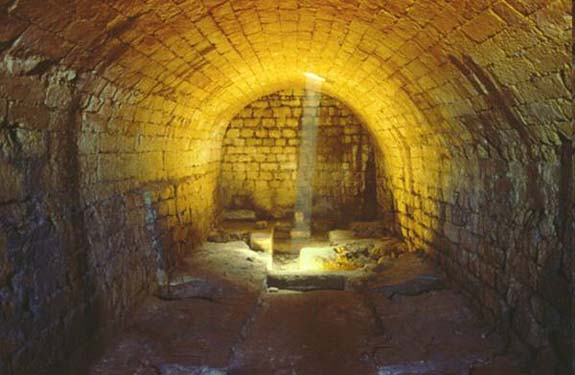
CIMRM Supplement - Mithraeum. Caesarea Maritima, Israel.
See also medallion of tauroctony.


In the summers of 1973-4 archaeologists working in Caesarea discovered a series of Roman barrel vaults near the harbour front. Eight were entered; twenty probably exist. These were constructed originally for grain storage, and built in the 1st century A.D., as a coin of Nero beneath the floor indicates. However vault 1 was later converted into a Mithraeum, in the third phase of use during the third century A.D., and perhaps earlier.
The vault is 4.94 m high, 4.95 m wide, and is 20.5 m long as now standing. It was originally 31.30 m long. It was built of soft limestone. Podiums were built at the end and on either side, 1.60 m wide, 0.4m high, 10.4m long. There are the remains of an altar, which was constructed at the east end, in front of the end wall, between the two podiums. There are traces of painted plaster along the vault next to the podiums. There are the remains of blue plaster at the very top of the vault, and small areas of white plaster with a few patches of reddish brown on the walls. Two shafts were cut to admit light into the Mithraeum at an angle, one of which admits light during June ever closer to the altar.
One large section of plaster has been preserved, on the south side at the east end of the podium. It is L. 2.20 x Br. 0.5 m. It contains the remains of three painted panels. Panel A (closest to the east) contains the lower legs and lower body of a standing figure, wearing close-fitting trousers (anaxyrides) and a tunic or cape. The stance suggests that the figure is extending his arms to the right, where there is a kneeling figure coloured mainly red. Panel B also contains two figures, as does panel C which may depict the handshake over a burning altar. The meaning of the frescos is not clear, but may be similar to those at S. Capua Vetere.
In an earth layer containing third century pottery, a small circular medallion was found depicting Mithras slaying the bull. The medallion is of white crystalline marble, 0.075m in diameter, and 0.01m thick. The upper half shows the tauroctony; the lower half scenes from the life of Mithras.
Above the Mithraeum is a water shelf and drain, built in the third century, which prevents water seepage into the section of the vault being used as a Mithraeum. Three columns bearing military memorial inscriptions of the third century have been found on this structure, and support the third century date.1
Subsequent work on the ceramics suggested that the Mithraeum could be earlier; possibly late first/early second century; possibly mid/late third centuries.2
Blakely has stated that the vault was converted into a Mithraeum in the early second century, and back to a warehouse in the mid- to late-third century.3
Coordinates: 32° 30' 00.77 N, 34° 53' 28.99" E / 32.500206° N, 34.891431° E.4
The archaeological work is now (2014) being readied for publication.5
Bibliography
- Lewis Moore Hopfe and Gary Lease, The Caesarea Mithraeum: A Preliminary Announcement, The Biblical Archaeologist, Vol. 38, No. 1 (Mar., 1975), pp. 2-10. JSTOR.
- Robert J. Bull, "The Mithraeum at Caesarea Martima," Études Mithriaques: Actes du 2e Congres International Theran du 1er au 8 septembre 1975. Leiden: Brill, 1978. Pp. 75-90. Preview online here.
- Bull, Robert J. "Caesarea Maritima: The Search for Herod's City." Biblical Archaeology Review vol. 8, no. 3 (1982): 24-40.
- Bob Fritzius' site on the Caesarea Maritima mithraeum.
- Robert Jehu Bull, Andrew H. Bobeck, Jane DeRose Evans, Robert S. Fritzius, Alexandra L. Ratzlaff, The Mithraeum at Caesarea Maritima (Archaeological Reports) (American Shools of Oriental Research Archeological Reports 25 / The Joint Expedition to Caesarea Maritima Excavation Reports) (Amazon link) American Schools of Oriental Research, 2017. ISBN-13: 978-0897570978.
| 1 | All this material abbreviated from Robert Bull's article. |
| 2 | Stephen E. Sidebotham, Review of: Jeffrey A. Blakely, Caesarea Maritima: the pottery and dating of vault 1: Horreum, Mithraeum and later uses, The Joint Expedition to Caesarea Maritima Excavation Reports IV. The Edwin Mellen Press, Lewiston, N.Y. 1987, in: American Journal of Archaeology, Vol. 94, No. 2 (Apr., 1990), pp. 363-364: "The vault was converted into a Mithraeum (ceramic phases 3-9) in the late first/early second-mid/late third centuries. It was in these levels that archaeologists found painted wall plaster, a small marble medallion depicting Mithraic scenes including Mithras tauroctone and lamps associated with the cult of Mithras in the second and third centuries. It was probably at that time that holes were cut in the vault ceiling to admit light into the cult area." JSTOR. |
| 3 | Jeffrey A. Blakely, Ceramics and Commerce: Amphorae from Caesarea Maritima, Bulletin of the American Schools of Oriental Research, No. 271 (Aug., 1988), pp. 31-50. p.35: "Vault 1 had been constructed as a warehouse but early in the second century it was converted into a Mithraeum, a function it served until the mid- to late third century, when it appears to have been reverted into a warehouse (Hopfe and Lease 1975; Bull 1978; 1982; Blakely 1987)." JSTOR. "Bull 1978" is "The Joint Expedition to Caesarea Maritima, Preliminary Reports in Microfiche: 1971-78. Madison, NJ: Drew Institute for Archaeological Research." "Blakely 1987" is: "The Pottery and Dating of Vault 1: Horreum, Mithraeum, and Later Usage, ed. Fred L. Horton. Joint Expedition to Caesarea Maritima Excavation Reports 4. Lewiston, NY: Edwin Mellen." |
| 4 | Supplied by Bob Fritzius - thank you. |
| 5 | Dr Szabo Csaba's list. |
| Tweet |